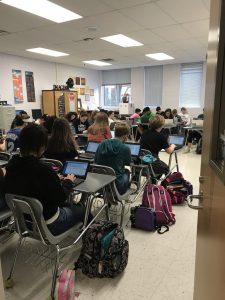My classes have finished reading Lord of the Flies, 1984, and Brave New World. Now, we are almost finished with The Time Machine. As I read their essays over Brave New World, I am excited and saddened to see the connections they are making between the dystopian literature and their lives. One of the most interesting ideas has been the connection between their electronic devices and the drug soma from Brave New World. I thought they would talk about the legalization of marijuana or the opioid crisis; they did not.
Ironically, this year, I have worked to use technology to enhance my curriculum and instructional strategies, so, when they are working in class on these blogs, or their notes over the readings, or our “Love Group” project, they are on their devices. As I look across the room right now, it is a sea of laptops, phones, and earbuds. No one is talking to each other outloud, but I know some are “chatting” with each other. The sound of clicking keys simultaneously makes me smile and cry for they are working, engaged, and learning, but they are also immersed in their own form of soma.
If you care, teaching is gut wrenching.





